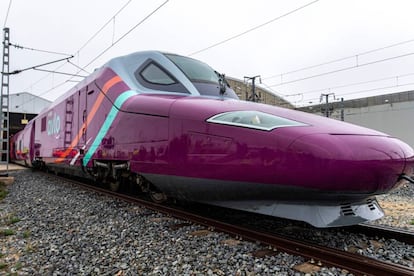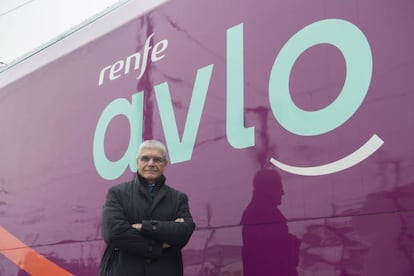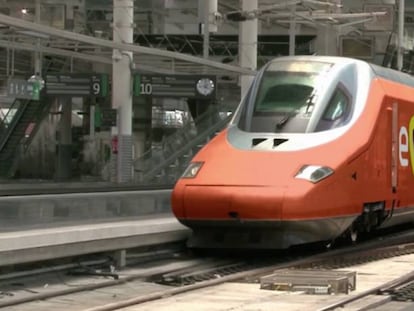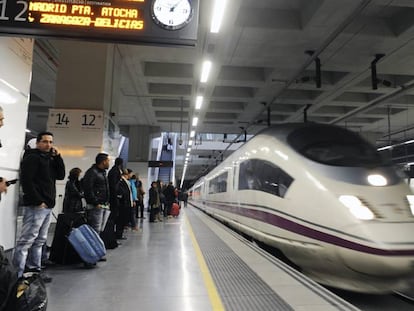Introducing Spain’s new low-cost AVE: €10 tickets for Barcelona to Madrid
The head of Renfe, Isaías Táboas, speaks to EL PAÍS about what the new budget high-speed train service AVLO will offer when it launches next year

Spain’s state-owned rail company Renfe will launch a new low-cost high-speed service called AVLO on April 6, 2020. That’s according to the proposal that the head of Renfe, Isaías Táboas, will bring to the company’s next management board meeting on Wednesday, December 18. The service will operate between Madrid and Barcelona, and tickets will cost between €10 and €60 per trip.
The current price of the high-speed AVE train between Madrid and Barcelona in economy class, without promotions, is between €40.95 and €152
Initially, the train will run twice a day in both directions, but this is set to increase to five services by the end of 2020. AVLO will run between Sants station in Barcelona and Atocha station in Madrid.
“The idea is to manage the rates dynamically,” Táboas explains during an interview with EL PAÍS. “My proposal to the board will be to have a range of prices from €10 to €60 per trip. This is not a promotional price but rather a price scale that will depend on demand at any given time. Of course, there are not going to be €10 tickets for everyone, but at some point everyone will be able to buy an AVLO ticket for €10 to travel between Madrid and Barcelona. So on April 6, there will be tickets for €10.”
The current price of the high-speed AVE train between Madrid and Barcelona in economy class, without promotions, is between €40.95 and €152, meaning AVLO is offering an average discount of 60%.
The AVLO schedule will depend on how the market responds to the new service. “We recognize that we have no experience in this type of product because up until now Renfe has not had a low-cost train. And one of the reasons to launch on April 6, 2020, without waiting for the liberalization [of domestic rail markets in the European Union in December 2020] is to be able to experiment, and get to know the market better. We will try [different schedules] and see whether peak hour or off-peak hours are better for us,” says Táboas.

One million passengers
Táboas says that Renfe expects AVLO to have one million passengers a year in the first two years of operation (2020 and 2021). “With AVLO we want to attract the people who don’t take the AVE today for economic reasons. We are talking about young people and families, travelers who basically are using the highway, be it in an individual car, shared vehicle or a bus,” says Táboas.
According to the Renfe chief, every year around 10 million people make the direct trip between Madrid and Barcelona – four million go by highway, another four million by AVE, and two million by plane. It is this first group that Renfe hopes to attract to the AVLO, said Táboas, adding that after 2021, Renfe “will consider a different public.”
Customers will be able to buy AVLO tickets primarily online and via a cellphone app, as well as over the phone or in person.
The low-cost train will only have economy class, with seats with the same foot space as the current AVE. It will not have a cafeteria or food service on board, although there will be at least one supervisor on the train to resolve any problems that might arise during the journey. Passengers will be able to connect to Wi-Fi for a fee, which will vary depending on the speed of the connection. The train will be staffed with workers from Renfe; a subsidiary company will not be created.
For it to be low-cost it has to have low-cost production Renfe chief Isaías Táboas
“The secret of this product is that for it to be low-cost it has to have low-cost production and we have optimized all the systems. All the complementary services that are associated with the current AVE will not be on the AVLO because it is a question of money that could impact the cost of tickets,” explains Táboas.
As for how many stops there will be on the route, Táboas says that this will depend on the demand for the new service: “To be able to offer these prices, it’s crucial that the trains are always full. [...] The more stops there are, the greater the likelihood that a seat will be empty at some point in the journey. That’s why we are going to look at the behavior of these new customers and the movement of travelers so that the train is as full as possible, and based on that, we will decide where it stops.”
The head of Renfe says that the name for AVLO is an “Anglicism” of AVE and low cost.
More competition
In December 2020, domestic rail markets in the European Union will be opened up to competition from other countries. Renfe is interested in competing in the European market, with France the main destination.
“Of course we would consider going to Paris. Perhaps not initially, but certainly in the future, because the major market is in lines such as Lyon-Paris or Marseille-Paris,” says Táboas.
English version by Melissa Kitson.
Tu suscripción se está usando en otro dispositivo
¿Quieres añadir otro usuario a tu suscripción?
Si continúas leyendo en este dispositivo, no se podrá leer en el otro.
FlechaTu suscripción se está usando en otro dispositivo y solo puedes acceder a EL PAÍS desde un dispositivo a la vez.
Si quieres compartir tu cuenta, cambia tu suscripción a la modalidad Premium, así podrás añadir otro usuario. Cada uno accederá con su propia cuenta de email, lo que os permitirá personalizar vuestra experiencia en EL PAÍS.
¿Tienes una suscripción de empresa? Accede aquí para contratar más cuentas.
En el caso de no saber quién está usando tu cuenta, te recomendamos cambiar tu contraseña aquí.
Si decides continuar compartiendo tu cuenta, este mensaje se mostrará en tu dispositivo y en el de la otra persona que está usando tu cuenta de forma indefinida, afectando a tu experiencia de lectura. Puedes consultar aquí los términos y condiciones de la suscripción digital.
More information
Archived In
Últimas noticias
Maduro pleads not guilty before the federal court in New York: ‘I am still the president of Venezuela’
A new test can detect Alzheimer’s from a finger prick
UN team enters Sudanese city of El Fasher after paramilitary massacre: ‘It’s like a ghost town’
A recipe for resistance: Indigenous peoples politicize their struggles from the kitchen
Most viewed
- Gilles Lipovetsky: ‘If you want to live better and fall in love, take Prozac, don’t look to philosophy’
- Alain Aspect, Nobel laureate in physics: ‘Einstein was so smart that he would have had to recognize quantum entanglement’
- Alvin Hellerstein, a 92-year-old judge appointed by Bill Clinton, to preside over Maduro’s trial in New York
- Maduro’s downfall puts China’s relationship with Venezuela to the test
- Why oil has been at the center of Venezuela-US conflicts for decades











































